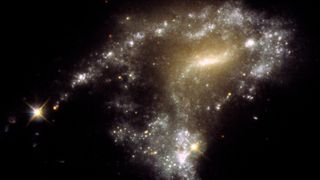
An example of one of the galaxies with a tidal tail imaged by the Hubble Space Telescope. This is the galaxy AM 1054-325, which is 173 million light years away.
(Image credit: NASA/ESA/STScI/Jayanne English (University of Manitoba))
The Hubble Space Telescope has stepped on the tails of 12 interacting galaxies and found them to be studded with the shining diamonds of young star clusters —scientists compare the phenomena to cosmic “strings of pearls.”
When spiral galaxies interact, either through direct collision or close encounter, their spiral arms unravel. The gravitational force that a galaxy wields is vast, so when two galaxies become close, the gravitational tides that are raised tug on those spiral arms, pulling them out to form long “tails” that can stretch for many tens of thousands of light-years.
Because spiral arms are loaded with gas and dust, when they are pulled out to form a so-called tidal tail, that gas and dust becomes stirred up. This, in turn, can ignite a firestorm of star formation. Hence, tidal tails can become the most intense star-forming regions in a galaxy.
Related: James Webb Space Telescope observes 19 intricate galaxy structures in stunning detail (images)
Now, astronomers led by Michael Rodruck of Randolph-Macon College in Virginia, U.S. have used Hubble images of 12 interacting galaxies spread across seven different interacting systems to identify 425 young, but massive, star clusters dotting those galaxies’ tidal tails. Each cluster contains about a million young, blue stars that emit plenty of ultraviolet light. By consulting archival ultraviolet observations of the galaxies, provided by NASA’s Galaxy Evolution Explorer (a mission that operated between 2003 and 2012) and the Swift mission, Rodruck’s team was able to determine the galaxies’ star-formation rates.
Coupled with the fact that these clusters have strong emission lines in their spectrums, resulting from hydrogen gas being ionized by the torrent of ultraviolet radiation, Rodruck’s team could then calculate the age of the clusters. Negative feedback from the young stars, in the form of stellar winds and radiation, eventually blows the gas out of the cluster; for it to still be present, as evidenced by the emission lines, means that the clusters must all still be younger than 10 million years.
“It’s a surprise to see lots of the young objects in the tails,” said Rodruck in a statement. “It tells us a lot about cluster formation efficiency. With tidal tails, you will build up new generations of stars that otherwise might not have existed.”
These tidal-tail clusters are extremely massive when compared to young star clusters in our galaxy, and are more akin to the ancient and compact globular clusters found in the Milky Way’s halo. Could Hubble be witnessing events similar to how globular clusters formed long ago, or will these young modern clusters eventually disperse?
The findings were published last year in Monthly Notices of the Royal Astronomical Society.
Join our Space Forums to keep talking space on the latest missions, night sky and more! And if you have a news tip, correction or comment, let us know at: community@space.com.
Breaking space news, the latest updates on rocket launches, skywatching events and more!
Keith Cooper is a freelance science journalist and editor in the United Kingdom, and has a degree in physics and astrophysics from the University of Manchester. He’s the author of “The Contact Paradox: Challenging Our Assumptions in the Search for Extraterrestrial Intelligence” (Bloomsbury Sigma, 2020) and has written articles on astronomy, space, physics and astrobiology for a multitude of magazines and websites.
>>> Read full article>>>
Copyright for syndicated content belongs to the linked Source : Space.com – https://www.space.com/hubble-space-telescope-star-formation-tidal-tail-galaxy-cluster
